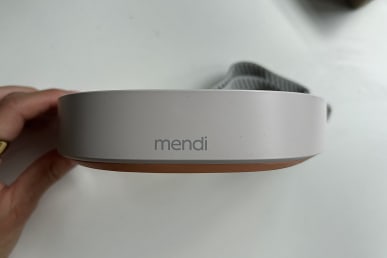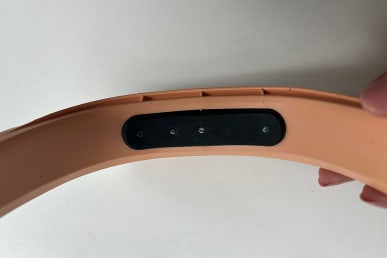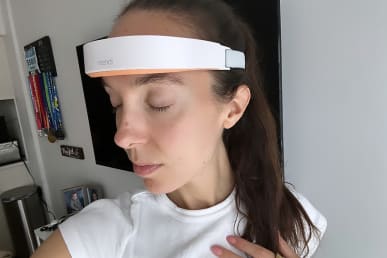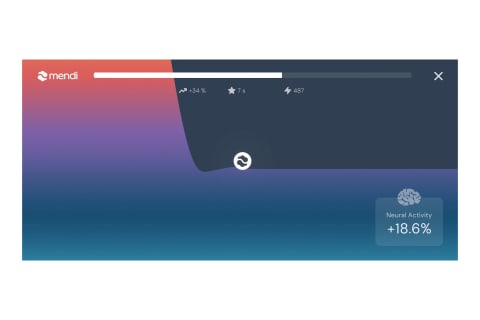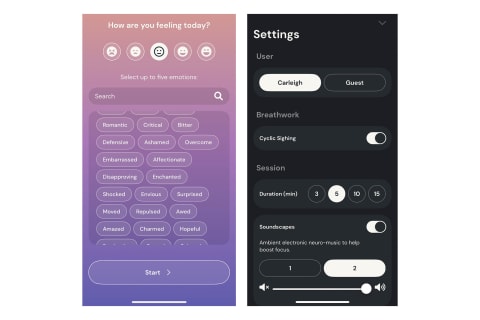Advertisement
I Tried The Mendi Brain Training Device To See If It Could Help My (Lack Of) Focus — Here’s My Honest Review


A few months ago, I realized the bulk of my workday struggles boiled down to focus (or a lack thereof). Research shows people tend to have more trouble concentrating as they get older, and I’m already feeling those changes despite only being in my thirties.
I’ll find myself zoned in on a task, only to receive a Slack message or email that makes me completely forget what I was doing. I wasn’t always so easily distracted, was I?
Eager to help my brain age as slowly as my body, I jumped at the chance to test the Mendi Headset. The neurofeedback device uses non-invasive sensors to monitor and train your brain for increased focus, improved sleep, and better emotion regulation.
But does it actually work? Below, learn what I love and what I'd change about the Mendi Headset, along with my results from testing it for one month.
mbg exclusive
Pros & Cons
Pros & Cons
Pros
App is free
Affordable compared to other neurofeedback devices
Gamifies brain training and tracks progress over time
Easy to use and sessions are short (3 to 15 minutes)
30-day trial
Cons
Not FDA-cleared
No large scale clinical trials
Not the most clear instructions
- Age: 35
- Primary concern: Focus
- Lifestyle: Active, prioritizes sleep and recovery, meditates three times per week
What is Mendi?
Founded by Rickard Eklöf and Sammy Saldjoghi in Stockholm, Sweden, Mendi Headset is a neurofeedback device meant to monitor and improve brain function.
The soft, fitted headband uses non-invasive functional near-infrared spectroscopy (fNIRS) technology to measure blood flow in the brain’s prefrontal cortex, allowing users to view and optimize their brain activity in real time using the corresponding Mendi Brain-Training app.
The Mendi Headset is designed to help improve focus, sleep, and mood regulation. The app gamifies the act of training your brain, providing scores at the end of each session and a log of your activity and progress.
How does Mendi work?
As opposed to other neurofeedback devices that monitor electrical impulses in your brain with electrodes (EEG) or analyze your brain waves, Mendi uses fNIRS technology or near-infrared light sensors to measure blood flow and oxygen levels in the prefrontal cortex of your brain.
When you're actively focusing, more blood flows toward your prefrontal cortex, which plays a vital role in decision-making, concentration, and emotion regulation. This make blood flow a good proxy-biomarker for brain activation.
But, rather than simply monitoring this data, Mendi uses a gamified app to help users optimize brain activity in real time. The app displays a visual representation of your brain activity, and you interact with it by actively focusing.
During each session, users are prompted to mentally commit to concentration in order to help the ball rise on the screen when the headset detects your brain being activated.
Mendi pairs these brain training sessions with a robust library of articles in the Explore tab on the brand’s app. The idea is that with consistent training, you’ll see long-term improvements.
The brand recommends a training protocol of three times per week for eight weeks to see improvements in focus, sleep, and emotional regulation.
How to use the Mendi Headset
To get started with your Mendi brain training headset, you’ll first need to make sure it’s fully charged and the app is downloaded on your phone (Android or iOS). The brand recommends completing your brain training sessions away from sunlight in a relaxed environment.
The headband should be worn with the sensors in the middle of your forehead (where your prefrontal cortex is located) below the hairline and above the eyebrows. You can adjust the band to the size of your head, making sure that it’s fitted closely against your skin (but still comfortable!).
After you press the power button on the headband, you’ll need to start the sensor within the app. Once the device calibrates with the app, you can select the length of your training session (from 3 to 15 minutes), and begin.
Throughout the session, you’re prompted to mentally commit to concentration in order to help the ball rise on the screen. At the end of your training, a score will be displayed to tell you how focused you were throughout the session.
Your Mendi Score is given on a scale from 0 to 100, determined based on a combination of your performance (brain training scores compared with your individual baseline) and commitment (session lengths and number of training days, both short- and long-term).
With consistent training, you should see your scores improve based on how well you activate your prefrontal cortex during each session compared with your own historical data.
All scores and progress metrics are then saved in the app so you can monitor your progress over time. The app also has an explore page with blogs and resources to learn more about the science behind Mendi and how to optimize your brain health.
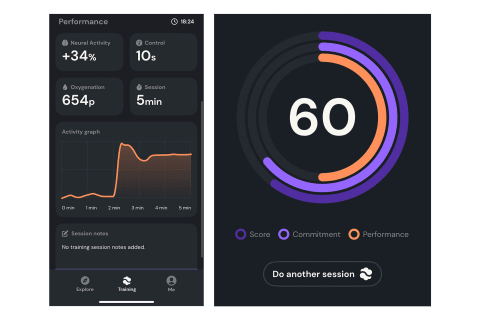
Potential benefits of the Mendi Headset
There are many ways to improve your attention span and optimize your brain health, but Mendi’s gamified neurofeedback technique helps bring this practice to life with real-time data.
While at-home fNIRS neurofeedback training is still new, a systematic review of 22 peer-reviewed studies found that fNIRS neurofeedback devices could be a powerful alternative to EEG and fMRI at a lower cost1.
What’s more, one small study found that this technique helped significantly improve focus and attention span2. As someone who gets easily distracted and has been struggling to focus, this was music to my ears.
My main goal was to improve my focus, but I’m also an avid sleep tracker so I was very interested in the potential to improve my Oura scores in the process of testing Mendi. While the Mendi Headset is not a direct sleep aid, the idea is that this form of brain training can minimize stress and ruminative thoughts (which negatively impact sleep3).
How much does Mendi cost?
The Mendi Headset costs $299 and the app is completely free. The brand also offers free international shipping, and there’s a 30-day money back guarantee.
My experience testing Mendi
I tested Mendi with the goal of achieving better focus and making myself less susceptible to distractions throughout the day. From the start, I loved how simple the headset was to set up.
Mine arrived 90% charged, so all I needed to do was download the app and set up my account (which took less than five minutes). I did find it a bit odd that the box came with no instruction manual—but no paper waste! Instead the app acted as a wealth of information about Mendi—and how to use it.
You can choose from a 3-, 5-, 10-, or 15-minute session, with the option to begin with one minute of cyclic breathwork to help relax your body. I chose five minutes to start and added on the breathwork.
There are a few additional settings you can play with (volume, music, soundscapes, etc.), but I kept everything on the standard settings. Before my session began, I was prompted to note how I was feeling by choosing from five emoticons and selecting five emotions that best represented my mood.
Once I hit start it took about five seconds for the headset to calibrate. Once it did, the screen turned into a visual representing my brain activity; as I focused on the ball, it would go up on the screen.
At first I found myself a bit distracted by trying to concentrate, but once I got into the groove I felt a sense of calm. My initial score was a 60, but even after those five minutes of intentional focus I felt better equipped for my day.
As for my aforementioned sleep scores, they’ve been on a hot streak as well—but there’s no saying if it’s the Mendi sessions or the myriad of other sleep aids I’m regularly using.
My Mendi scores have improved slightly over the past two weeks of testing, but what really surprised me is the impact I’ve felt in daily life. I feel more zoned in and less stressed, and I’m not as easily distracted.
Is Mendi worth it?
Whether the Mendi Headset is worth it depends on your budget and your goals for the device. Many users rave about the improvements they’ve experienced to their sleep, focus, and mood after using Mendi regularly—and, if you’re struggling with any of the above and have the budget to spare, Mendi could be a great investment.
Other similar devices are the Sensi.ai ($1,500) and the Muse ($445), which both have membership fees as well. Of course it’s worth noting that both of these devices do measure brain waves, while Mendi measures blood flow and oxygen levels.
Considering the 30-day warranty and the lower price point compared to other neurofeedback devices, Mendi is a great option for anyone who is curious about brain training and wants to test it out before committing to a large expense.
On the con side, Mendi is not FDA-cleared, and there are no large-scale studies supporting its claims. That said, studies indicate that the technology Mendi uses is safe4, and I’d recommend it primarily for people who like to be on the cutting edge of trying new technology.
Reminder: If you have an existing health condition, or you are not sure whether the Mendi Headset is safe for you, it’s best to consult with a healthcare professional.
FAQ:
Is Mendi brain training legit?
Like other neurofeedback training devices, Mendi Headset is not FDA-cleared (nor a medical device). But Mendia is a reputable company with positive customer feedback. The device is easy to use and the technology has some research to back it, with very few safety concerns.
Is Mendi brain training for ADHD?
The Mendi Headset was not specifically designed to help people with ADHD, but it was designed to help improve focus—so it could have some benefits for people with ADHD.
Of course, it’s important to note that the efficacy and safety of Mendi for people with ADHD has not been thoroughly studied. If you are not sure whether you should use the Mendi, it’s best to consult with a healthcare professional for individual advice.
Does Mendi help with anxiety?
There are positive reviews from users who have used Mendi to help reduce anxiety. However, there have been no substantial studies to support these claims.
How much does Mendi cost?
The Mendi Headset costs $299 and the app membership is free. International shipping is also free.
The takeaway
Just like we train our bodies to be able to perform difficult tasks when we’re older, we need to exercise our brains to stay in top shape. A lack of focus impacts just about every aspect of your day-to-day life, and our ability to focus depletes with age.
Mendi’s gamified technique helps train your brain for better focus, improved sleep, and even better mood regulation—so you can keep your brain younger for longer. Plus, save 15% with code MBG15.
Curious about your own brain function? Check out these signs you need to care for your brain (and how to do it).
